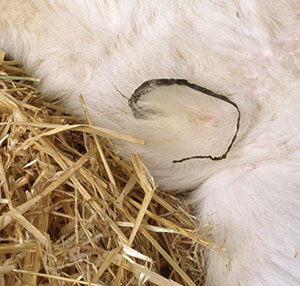Healthy Calf Conference
Follow to stay up-to-date on all Healthy Calf Conference updates. Speaker announcements, sponsorship information, registration announcements, and more.
A navel cord is a highway into a calf’s bloodstream. Proper management of the navel right after birth can ensure a calf gets off to an infection‐free start.
The umbilical cord is made up of blood vessels that, after calving, remain like hollow tubes where bacteria can enter the calf, and get into the bloodstream. Once in the bloodstream, the bacteria can circulate throughout the calf’s body, causing diseases like septicemia (blood infection), meningitis (brain infection) and arthritis (“joint ill”, swollen joints).

Navel problems include wet navels, navel infections, and/or umbilical hernias. Navels that don’t dry up are often infected. Infection enlarges the navel cord and impedes the closure of the opening into the calf’s abdomen. If the opening is big enough, the calf’s intestine can herniate (protrude through the opening). This is called an umbilical hernia. Herniation may damage the bowel. Some small hernias eventually close on their own; however larger ones require treatment or even surgery to fix them. Management at calving is the key to avoiding navel issues. Often keeping the bedding in the calving area dry and dipping the calf’s navel in disinfectant right after birth solves navel‐related problems. A clean calving area reduces the exposure of the navel area to bacteria in manure, urine and dirt. Dipping the navel right after birth dries it out, helps the large blood vessels to close and kills any bacteria already present. Repeated dipping of enlarged cords over the first few days of life is a good practice. Ensuring everyone handling calves knows what to look for and knows to check the navels routinely can help with early detection of navel problems.
It is recommended that calves need to be at least seven days old and have a dry navel before they are moved from the home farm to a sales barn. Sending calves that are too young or have wet and infected navels to a livestock auction is a welfare issue. A poor start greatly affects the future health and productivity of these calves and the reputation of your farm.
“There are no problems with the vast majority of calves, but we do see calves every week with navels that haven’t healed yet,” explains Mike Draper, Livestock Community Sales Co‐ordinator with the Ontario Ministry of Agriculture, Food and Rural Affairs. “It’s not a good idea to bring calves to a sale facility with navel cords that aren’t healed yet as it significantly increases the risk to the calf, allowing bacteria to travel up the navel cord. They are more likely to get ill.”
Calves that do show up for sale with any of these navel conditions run the risk of being returned to the producer, treated at the sale facility at the producer’s expense, or, in worst cases, humanely euthanized if they’re found to be too sick to recover.
“Good navel management is important all year round and it comes down to proper monitoring and management on the farm,” Draper adds. “It is well worth investing the time and effort in a good calf management system. It’s the right thing to do for the welfare of the calf”.
Here’s what you can do to ensure you’re shipping healthy calves with clean, dry navels:
Ensure you have a protocol in place to deal with enlarged or infected navels. Work with your veterinarian to write a treatment plan for this condition. Follow the protocols they recommend. Treat calves with infected navels promptly.
Thank you to Dr. Ann Godkin from Ontario Ministry of Agriculture Food and Rural Affairs (OMAFRA) for her contribution to this important topic.
1Drying times of umbilical cords of dairy calves, Australian Veterinary Journal
Follow to stay up-to-date on all Healthy Calf Conference updates. Speaker announcements, sponsorship information, registration announcements, and more.
The Codes of Practice are nationally developed guidelines for the care and handling of farm animals. They serve as our national understanding of animal care requirements and recommended practices.